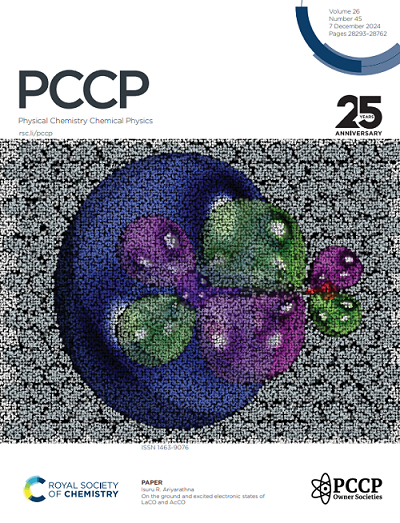Nanoscopic Feldspar Islands on K-Feldspar Microcline (001)
IF 2.9
3区 化学
Q3 CHEMISTRY, PHYSICAL
引用次数: 0
Abstract
Feldspar minerals are abundant rock-forming minerals playing a central role in environmental processes such as silicate weathering and ice nucleation in mixed-phase clouds. These processes typically take place at the feldspar-water interface, which is why the micro- and nanoscopic surface topology is of major importance to understand them. However, especially in the field of ice nucleation on feldspar surfaces, most experimental studies are limited to the micrometer scale, while the ice nucleation sites are expected to be nanometre sized. Here, we report an intrinsic island structure observed on microcline (001). High-resolution atomic force microscopy (AFM) images taken in ultra-high vacuum show nanometre-sized islands on the terraces and at the step edges. Atomic scale images revealing a very similar contrast and identical lattice parameters on the terrace and on the islands suggest that these islands are an intrinsic feature of the microcline surface. Moreover, AFM at the solid-liquid interface demonstrates that the observed nanostructure is stable in water. As the existence of islands significantly increases the density of edge and kink sites, the observed nanostructure might have important implications for surface reactivity and potentially ice nucleation efficiency.k -长石微斜长石上的纳米长石岛(001)
长石矿物是丰富的造岩矿物,在硅酸盐风化和混合相云冰核等环境过程中起着核心作用。这些过程通常发生在长石-水界面,这就是为什么微观和纳米表面拓扑结构对理解它们非常重要的原因。然而,特别是在长石表面冰成核领域,大多数实验研究仅限于微米尺度,而冰成核位点有望达到纳米尺度。在这里,我们报告了在微斜上观察到的本征岛结构(001)。在超高真空条件下拍摄的高分辨率原子力显微镜(AFM)图像显示,在梯田和台阶边缘有纳米大小的岛屿。原子尺度图像显示阶地和岛屿上非常相似的对比度和相同的晶格参数,表明这些岛屿是微斜表面的内在特征。此外,在固液界面处的原子力分析表明,所观察到的纳米结构在水中是稳定的。由于岛屿的存在显著增加了边缘和扭结位点的密度,因此观察到的纳米结构可能对表面反应性和潜在的冰核效率具有重要意义。
本文章由计算机程序翻译,如有差异,请以英文原文为准。
求助全文
约1分钟内获得全文
求助全文
来源期刊

Physical Chemistry Chemical Physics
化学-物理:原子、分子和化学物理
CiteScore
5.50
自引率
9.10%
发文量
2675
审稿时长
2.0 months
期刊介绍:
Physical Chemistry Chemical Physics (PCCP) is an international journal co-owned by 19 physical chemistry and physics societies from around the world. This journal publishes original, cutting-edge research in physical chemistry, chemical physics and biophysical chemistry. To be suitable for publication in PCCP, articles must include significant innovation and/or insight into physical chemistry; this is the most important criterion that reviewers and Editors will judge against when evaluating submissions.
The journal has a broad scope and welcomes contributions spanning experiment, theory, computation and data science. Topical coverage includes spectroscopy, dynamics, kinetics, statistical mechanics, thermodynamics, electrochemistry, catalysis, surface science, quantum mechanics, quantum computing and machine learning. Interdisciplinary research areas such as polymers and soft matter, materials, nanoscience, energy, surfaces/interfaces, and biophysical chemistry are welcomed if they demonstrate significant innovation and/or insight into physical chemistry. Joined experimental/theoretical studies are particularly appreciated when complementary and based on up-to-date approaches.
 求助内容:
求助内容: 应助结果提醒方式:
应助结果提醒方式:


